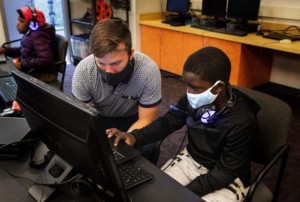8 Ways to Teach Empathy and Cultivate Community

Earlier this week, I participated in a Twitter chat sponsored by the Ashoka Changemakers (@AshokaUS) series and their #StartEmpathy and #ThinkitUp projects.
And no matter how vitriolic the fight, we can’t forget we have more in common than in opp to those we engage #StartEmpathy
— Patrick Riccards (@Eduflack) September 8, 2015
A3: Ask open ended questions. Then listen. Ask another question. Allow kids’ voices to be heard. #ThinkitUp #StartEmpathy — Bonnie Lathram (@belathram) September 8, 2015
While we often think that empathy is “walking in someone else’s shoes” it is also about connecting students to one another in a community and creating a sense of belonging. Hear students talking about empathy:
Here are eight ways to teach empathy and cultivate community in your classroom this year:
1. Role Play
I took a group of 9th graders once to the World Relief Center in Seattle (my class was featured in a story in the Seattle Times). My students had to role play what it was like to become a US citizen. They were given different roles to play in a family of emigrants. One of my students, Shytwan, was given the role as a “father” in a Chinese family that was emigrating to the US in the 1880s. When reflecting about the activity, Shytwan said, “I learned about being a father.” The experience of role playing a father was something unique and new. For Shytwan, the real learning was about placing himself in the shoes of someone else and assuming a new role.
Top tip: Have students role play as much as possible. Allow them to assume roles they may not have experienced before, and encourage reflection afterwards. Ask, “What did it feel like to be in the role of someone else?”
2. Teach Forgiveness
Of the hundreds of Socratic discussions I’ve led, one topic was so memorable that I encourage you to discuss them with your students (especially if you have high school students).
For the topic of “forgiveness,” we read an article about a school shooting that took place in the Amish community in 2006. The Amish members of the community, those even still grieving, showed up at the funeral of the shooter, and forgave the man who had killed many of their own community members. We all read the story together and then the group of students started sharing their own stories of forgiveness, people they needed to forgive and those that they couldn’t. This allowed the class to create deeper connections to one another.
Top tip: Talk about real feelings even when (or especially when) there are no real answers. Topics include: Forgiveness, Love, Regret, Longing, Loneliness, Loss, Elation. Anchor these topics in the readings of poetry, literature and current events. Students often do not have a way to share their feelings. Your classroom could be the safe space they are waiting for. (Note: Involve appropriate staff if conversations raise warnings that need to be addressed by counselors and/or outside agencies).
3. Start the Hot Seat
The last 15 minutes of each Friday, my students and I circled up and one student’s name was chosen out of a hat for the Hot Seat. Being in the hot seat meant other students in the class were able to ask that student questions about his/her personal and/or academic qualities during the week. Students asked questions such as “Why were you late coming back from lunch on Wednesday?” and “What are your goals for next week?” and “If you had something to do differently this week, what would it have been?”
Top tip: As the teacher, put yourself in the Hot Seat. Students will ask you questions to hold you accountable.
4. Celebrate Culture and Identity
At my former school, the students and staff created distinct clubs that anyone was allowed to join that focused on representing specific cultures. The clubs created dances, held school wide festivals, went on field trips, led fundraisers and taught younger students in our district. They modeled inclusion and acceptance of all and allowed students to bring in and represent their culture and identities. The LBGQT group every year held a day of silence, where many of our students did not talk (and even a couple of the teachers!).
Top tip: Get the school community learning about one another, celebrating and having fun together.
5. Listen to All Students
I noticed over the course of my 8 years of teaching that each year I talked less and listen and listened more. A principal once suggested that the ratio of questions to statements should be somewhere in the neighborhood of 7 to 1. For every declarative statement you make to a student (“You really should do your math homework”), you could ask 7 questions such as: “What’s getting in the way of you being successful? How can I better help you? What do you think you need? What are some of your goals?”
Top tip: Have students practice asking questions to one another and write down a list of questions on the wall of your classroom. Students can interact with one another by asking questions and get practice thinking about their responses.
6. Create an Exit Ticket
I almost always ended classes by walking to the door and not letting kids leave until they handed me either an exit ticket or answered my “Question of the Day”. Sometimes these were meaningful and deep reflections and other times they were for fun. This allowed me to learn more about the student that I could use in 1:1 conversations later. These led to cool conversations between students. Certain things you glean from students in a quick conversation pay off in spades later.
Top tip: Ask questions, learn more. Get kids talking, then listen.
7. Share Your Own Feelings
As a teacher, there are opportunities to model and show how you handle yourself in interactions with other adults. Students are watching your every move. If there’s someone else that you work with that is difficult, how do you treat that person? How do you interact with all people you come into contact with during the day? The students are watching.
Top tip: Create an emotions wall (or use emotions cards–see below) and put it up in your classroom. This gets students into the habit of identifying how they feel. It’s easier to have empathy for (and create connections with) others if we really do know how it feels, if we can identify the feeling and name it.

8. Teach Students How to Give Authentic Feedback
Here’s a challenge this year. Ask your students to give you feedback. Not sure if you did a great job teaching that math/history/science lesson? Ask—and ask for honesty. Then don’t get hurt when they tell you something didn’t go well. Think of it as an opportunity to improve–we become better teachers with time and we grow with feedback. Create anonymous surveys. Have students fill out reflections that can help you get better as a teacher. Share the results. Analyze them like you would other data–with your class. The more open you are in modeling, the more likely students will accept your authentic feedback.
Top tip: Create an open dialogue of trust and watch the classroom community thrive.
Teachers model and empathy connection. Teachers that can connect with students teach students how to connect with one another. Share ideas about ways that you promote and teach empathy on the #StartEmpathy hashtag and join in the conversation.
For more on teaching empathy, check out all the great resources on the Ashoka Changemakers site and see:
- 8 Ways to Encourage Soft Skills in Our Children
- Leaders, Learners and Designers All Listen First
- Parenting with Social and Emotional Learning: Thinking Before and After Actions
Stay in-the-know with all things EdTech and innovations in learning by signing up to receive the weekly Smart Update.






Volatire
Hot Seat? That sounds positively emotionally abusive. Why on earth would you or anyone else think this is a positive use of valuable classroom time? Selecting a child randomly to be targeted by his or her peers for infractions real or imagined for which they are supposed to perform some sort of EST-like confession for absolution for better self understanding? No. This is group processes to create cognitive dissonance and break the individual. Do your research on Lewin, Luria and Vygotsky and then just teach academics. Please.
Bonnie Lathram
Thanks so much for reading the blog and your comments. We appreciate the time you took to both read the blog and also comment. We appreciate your insights.